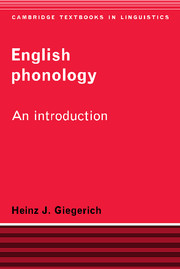Book contents
- Frontmatter
- Contents
- Preface
- 1 Speech sounds and their production
- 2 Towards a sound system for English: consonant phonemes
- 3 Some vowel systems of English
- 4 Phonological features, part 1: the classification of English vowel phonemes
- 5 Phonological features, part 2: the consonant system
- 6 Syllables
- 7 Word stress
- 8 Phonetic representations: the realisations of phonemes
- 9 Phrases, sentences and the phonology of connected speech
- 10 Representations and derivations
- References
- Index
4 - Phonological features, part 1: the classification of English vowel phonemes
Published online by Cambridge University Press: 05 June 2012
- Frontmatter
- Contents
- Preface
- 1 Speech sounds and their production
- 2 Towards a sound system for English: consonant phonemes
- 3 Some vowel systems of English
- 4 Phonological features, part 1: the classification of English vowel phonemes
- 5 Phonological features, part 2: the consonant system
- 6 Syllables
- 7 Word stress
- 8 Phonetic representations: the realisations of phonemes
- 9 Phrases, sentences and the phonology of connected speech
- 10 Representations and derivations
- References
- Index
Summary
The role of features in phonology
Any serious scientific enquiry, if it is to yield objectively valid results, requires a strict methodology: it needs to define its terms, the precise nature of the units denoted by these terms, as well as the operations through which such units are established. One such unit of phonological analysis is the phoneme, defined (in sect. 2.2) as the minimal contrastive sound unit of a language. This definition has furnished us with a simple and entirely objective method of establishing phonemes: the commutation test. Two phones are realisations of different phonemes if they produce phonological contrast; that is, if they figure in at least one minimal pair. Recall that this is not, strictly speaking, the whole story: we had to provide an additional definition of the allophone in section 2.2 to ensure that /h/ and /ŋ/ are different phonemes; and in section 3.4 we encountered some methodological problems that are so far unresolved. But we can conclude that the central unit of our analysis – the phoneme – is based on sound methodological principles. The problems of section 3.4 will eventually be resolved.
We also noted at various points of the preceding investigation that phonemes are not unanalysable (‘atomic’) elements, but that they can be analysed further. While a phoneme cannot by definition be broken up into shorter successive units, it can be viewed as a bundle of simultaneous units called phonological features: individual properties whose sum makes up the phoneme.
- Type
- Chapter
- Information
- English PhonologyAn Introduction, pp. 89 - 111Publisher: Cambridge University PressPrint publication year: 1992



